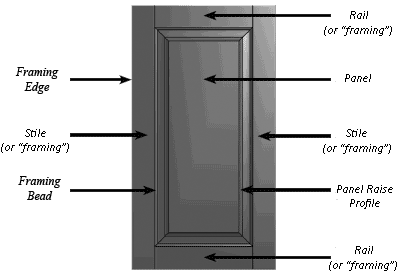Anatomy of a Cabinet
I started working at The Cabinetry as an Office Manager in June and I had exactly zero experience in the kitchen and bath remodel industry. The designers started throwing around these different industry terms which baffled me. Inset, frameless, overlay, stiles, rails… they made it seem easy. I just stared at them. What does it all mean?
I did a little research. Let’s see if I can demystify the cabinet experience for you. I’ll describe all of the terminology in layman’s terms…the only way I can understand it myself!
I found this drawing of the cabinet door very helpful.
Stile: Vertical piece of cabinet door frame, there is one on the left and right side of the door.
Rail: the horizontal piece of the cabinet door frame at the top and bottom of the door.
Framing Edge: the cut of the outside of the cabinet door frame.
Framing Bead: the decorative inside edge of the door frame.
Panel Raise Profile: the decorative cut made to the face of the of the raised panel, which highlights the fact that the panel is a separate piece from the framing.
The panel can be either flat or raised. If the panel is raised it looks much like the door pictures above. The frame and the panel meet, and the panel is elevated above the frame.
A flat panel is exactly as it sounds. The panel will just be flat, straight across.
The actual cabinet box can be either framed or frameless. If you decide to make the cabinet frameless, it is almost as if you are making the cabinet “all access.” It makes for easy accessibility. The cabinet is constructed without a face frame and instead relies on a thicker box construction for more stability.
It is also important to know the difference between full and partial overlay cabinets, and inset cabinets. A full overlay cabinet is one where the doors and drawer fronts completely cover the face frame.
A partial overlay cabinet still shows a portion of the face frame.
Inset cabinetry features doors and drawers which fit inside of the cabinet face frame opening.
Understanding the different parts of the cabinet doors, the box choices and the door framing can really help you decide how you want your kitchen/bathroom to look. And if you go into the process informed it can really help your designer make your space phenomenal.
I found this hinge diagram very helpful when trying to understand different cabinetry terms:
So maybe the whole cabinet process isn’t as confusing and befuddling as it seems. There is much more to learn if you’re a cabinet professional but hopefully you learned a little in this foray into the cabinet world. I certainly did.
-Posted by Jennifer Hubbard

